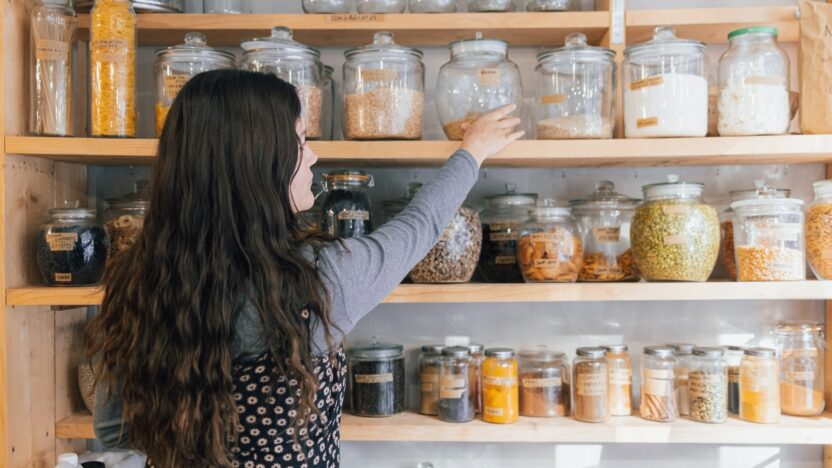The kitchen is a great place to start your zero-waste journey, as it’s where much of our daily waste—like food scraps and packaging—comes from. A zero-waste kitchen reduces trash, saves money, and makes cooking more sustainable. With simple swaps and smart habits, you can transform your kitchen into an eco-friendly hub. This guide shares practical steps to create a waste-free kitchen that works for you. For more sustainable living ideas, visit For Organic Life.
Replacing Disposables with Reusable Alternatives
Disposable items like paper towels, plastic bags, and single-use containers create significant waste. Replacing them with reusables is a key step toward a zero-waste kitchen. Here are some swaps:
- Cloth Towels: Use organic cotton or bamboo towels instead of paper towels for cleaning or drying. They’re washable and durable.
- Silicone Baking Mats: Replace parchment paper or foil with reusable silicone mats for baking. They’re non-stick and easy to clean.
- Glass Containers: Store leftovers in glass or stainless steel containers instead of plastic wrap or bags.
- Reusable Coffee Filters: Use a metal or cloth filter for coffee makers to skip paper filters.
Start with one swap, like cloth towels, and add more over time. Keep reusables accessible—store towels near the sink or containers in a handy drawer. Wash items regularly to maintain hygiene. These changes cut waste and add style to your kitchen.
Storing Food to Reduce Waste
Proper food storage prevents spoilage and reduces waste. Using eco-friendly storage solutions keeps your kitchen organized and sustainable. Try these ideas:
- Glass Jars: Store dry goods like grains, beans, or spices in mason jars or reused sauce jars. They’re airtight and keep food fresh.
- Beeswax Wraps: Cover bowls or wrap produce with reusable beeswax wraps instead of plastic wrap. They’re moldable and washable.
- Stainless Steel Tins: Use metal containers for snacks or lunches on the go. They’re durable and recyclable.
- Produce Bags: Store fruits and vegetables in breathable cotton or mesh bags in the fridge to extend freshness.
Label jars with contents and dates to stay organized. Store perishables like berries in glass containers with a cloth to absorb moisture. Check your pantry regularly to use older items first. These storage solutions minimize food waste and keep your kitchen clutter-free.
Composting Kitchen Scraps Effectively
Composting is a cornerstone of a zero-waste kitchen, turning scraps into valuable soil. Here’s how to compost effectively:
- Choose a Bin: Use a small, lidded countertop bin for daily scraps. Outdoor compost bins or tumblers work for larger volumes.
- Compostable Items: Include vegetable peels, fruit cores, coffee grounds, and eggshells. Avoid meat, dairy, or oily scraps to prevent odors.
- Balance Materials: Mix “green” scraps (like food) with “brown” materials (like dry leaves or cardboard) to speed decomposition.
- Maintain the Pile: Turn your compost weekly to aerate it and keep it moist, like a wrung-out sponge.
For small spaces, try bokashi composting, which ferments scraps in a compact bin. If composting isn’t possible, find local drop-off sites or community gardens that accept scraps. Composting reduces landfill waste and supports your garden or local growers.
Meal Planning to Minimize Food Waste
Meal planning helps you buy only what you need, cutting food waste and saving money. Here’s how to plan effectively:
- Make a Weekly Menu: Plan meals based on what’s in your pantry or fridge to use existing ingredients.
- Shop with a List: Stick to your list to avoid impulse buys that might spoil. Buy in bulk for staples to reduce packaging.
- Batch Cook: Prepare large meals and store leftovers in reusable containers for easy lunches or dinners.
- Use Scraps Creatively: Turn vegetable scraps into broth or use overripe fruit in smoothies.
Check your fridge before shopping to avoid duplicates. Freeze extras, like soups or bread, to extend shelf life. Keep a “use first” shelf in your fridge for items nearing expiration. Meal planning streamlines cooking and keeps your kitchen zero-waste.
Sourcing Zero-Waste Kitchen Supplies
Finding sustainable kitchen supplies is key to maintaining a zero-waste routine. Here’s where to look:
- Zero-Waste Stores: Shop at bulk stores or zero-waste shops for package-free items like soaps, spices, or reusables.
- Farmers’ Markets: Buy fresh produce without packaging and support local farmers. Bring your own bags and containers.
- Online Retailers: Websites like Package Free or Zero Waste Store offer eco-friendly tools, from silicone lids to bamboo utensils.
- Secondhand Shops: Find glass jars, stainless steel containers, or cloth napkins at thrift stores for budget-friendly options.
Check for certifications like Fair Trade or USDA Organic to ensure products are sustainable. Ask store staff about package-free options or bulk bins. For more sourcing tips, visit For Organic Life. Shopping thoughtfully builds a green kitchen with minimal waste.
Crafting a Waste-Free Kitchen
A zero-waste kitchen is achievable with small, intentional steps. By replacing disposables, storing food smartly, composting scraps, planning meals, and sourcing sustainable supplies, you can cook sustainably and reduce waste. Start with one change and build your routine over time. Enjoy the simplicity and savings of a greener kitchen!




